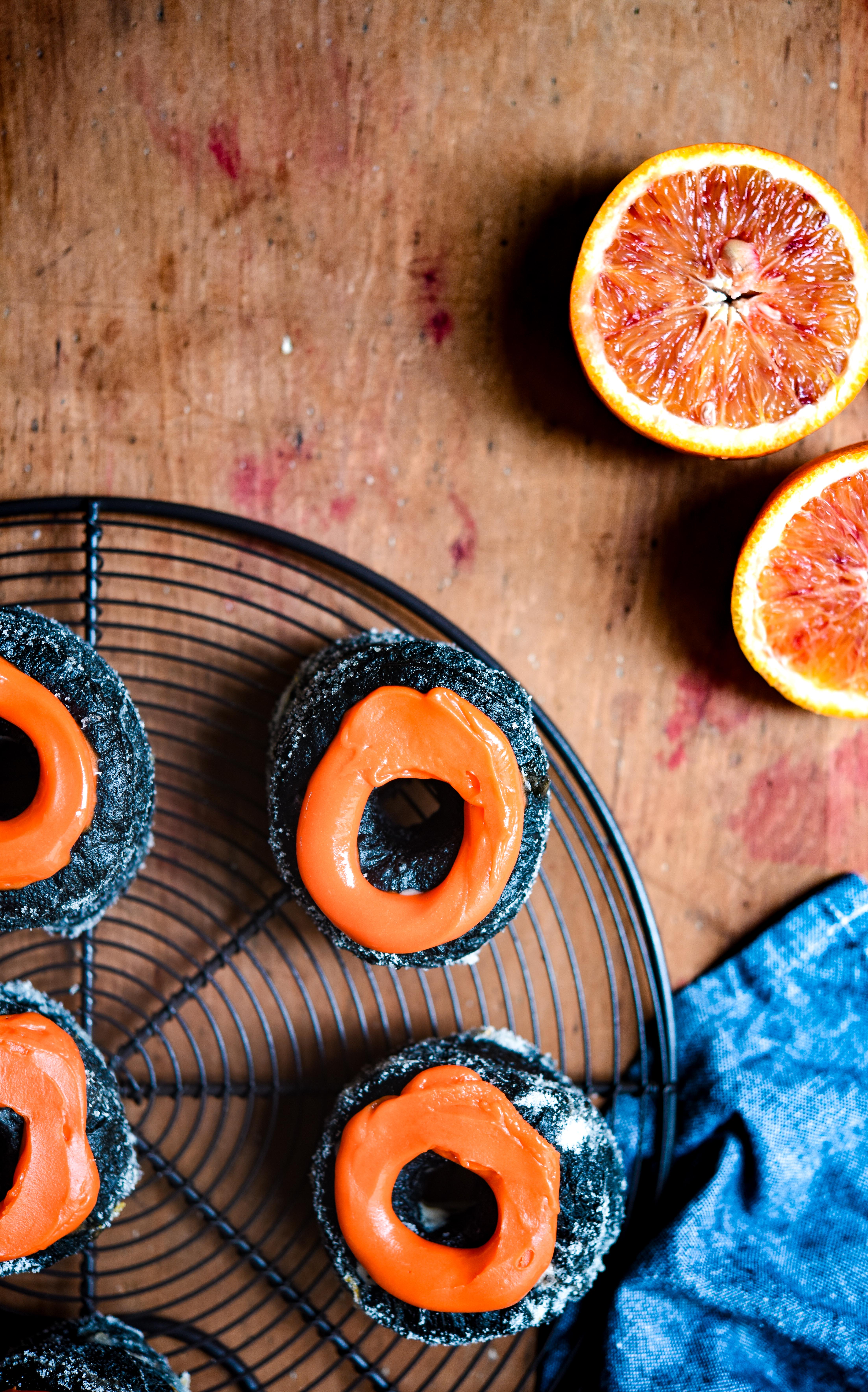***Two days before you make your cronuts***
To make the blood orange whipped ganache soak the gelatine sheets in a bowl of cold water and leave to one side to soften and bloom.
Place the cream and sugar in a saucepan and bring to the boil, remove from the heat and squeeze out the water from the gelatine sheets.
Add it to the warmed cream and mix until the gelatine has dissolved. Place the chocolate in a bowl and pour the warm cream over the top, stir with a spatula until combined and smooth, let the ganache cool to room temperature.
Whisk in the blood orange juice, cover with clingfilm pressed directly on the surface of the ganache and place it in the fridge to set.
To make the croissant dough, combine the strong flour, charcoal, salt, sugar, yeast, water, egg white, butter and cream in the bowl of a stand mixer fitted with a dough hook. Mix until just combined around 2-3 minutes. When finished the dough should be shaggy and will be a bit sticky.
Lightly grease a medium bowl and transfer the dough to the bowl. Cover the bowl with clingfilm making sure it touches the dough so that it doesn't form a skin.
Proof the dough somewhere warm for 2-3 hours or until doubled in size.
Remove the clingfilm and knock back the dough by folding in the corners to remove as much air as possible.
Lay the dough onto a piece of greaseproof paper and shape into a 25cm square, remove the dough from the greaseproof paper and wrap it in clingfilm. Place on a baking tray and chill overnight in the fridge.
Next make the butter block, draw a 18cm square on a piece of greaseproof paper and turn it over, place the butter in the centre of the square and spread it evenly with an offset spatula to fill the square. Wrap the butter block in the greaseproof paper and place in the fridge overnight.
***One day before you make your cronuts***
Take the butter block from the fridge along with the pastry. Place the pastry on a lightly floured surface, you don't want to add too much flour or it will make the pastry tough. Position the butter block in the centre at an angle, so it looks like a diamond on top of the pastry.
Fold over the corners of the pastry and bring them into the middle, completely cover the butter and pinch the joins together. You will then have a square of pastry.
With even pressure, roll the dough until it forms a square that is double in size.
Now fold the dough in half horizontally, and then in half again vertically, to create a square of folded dough.
Place the dough in the fridge for an hour to rest, then repeat the previous steps rolling the dough out to make a square twice the size and then fold the dough in half and then half again to make a square.
Rest the dough in the fridge overnight to relax.
***On the day of making the cronuts***
Remove the cronut dough from the fridge and roll it out to a rectangle around 40cm by 20cm, take a 9cm and a 2.5cm round cutter. Use the large cutter and then use the smaller cutter to create a ring. You should get 12 cronuts out of the dough.
Line two baking trays with parchment and dust it lightly with flour, place the cronuts on the tray, 5cm apart to allow them to prove for at least 2 hours or until doubled in size. You will have some dough leftover, but don't be tempted to use it, as it won't prove evenly.
Heat 1 litre of oil to 175C in a pan and fry the cronuts in small batches, two at a time fry for 90 seconds on each side.
Drain the cronuts on kitchen towel on top of a cake rack and let cool to room temperature.
Take the chilled ganache and place it in the bowl of a stand mixer with a whisk fitted, whisk the ganache until it forms stiff peaks.
Place the ganache in a piping bag fitted with a bismarck tip and leave in the fridge until you're ready to use it.
Take the cooled cronuts and using the tip pierce each cronut in the top in 4 places and fill with the ganache.
Make the flavoured sugar by combining the zest of the blood orange with the granulated sugar and place to one side to infuse.
Take the fondant and place in a microwavable bowl, blast the fondant in the microwave on high in 10 second increments until the fondant is a thick but pourable consistency.
Add the blood orange juice and the food colouring until you get the shade of orange and the consistency you want. Place the fondant in a piping bag and cut off the tip.
Take the filled cronuts and roll the sides in the flavoured sugar, then pipe rings of the icing on top of the cronut, making sure to cover the holes of the ganache filling.
Try to eat the cronuts within 24 hours to appreciate them at their best.
